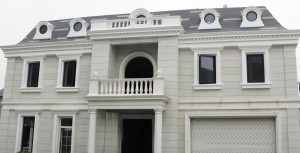Share This
Related Posts
Tags
3D Printed Apartments
By Anca Gagiuc on Mar 24, 2015 in Technology
Gutenberg invented the printing press in 1439; since then the printing industry has evolved, from printing blocks to 2D printers with the capacity of mass-producing documents in just minutes. Today, 3D printers are capable of creating pretty much anything, from mechanical parts to prosthetics to buildings.

Believe it or not, this mansion was made with a 3D printer. Image courtesy WinSun Decoration Design Engineering.
Even though it’s been 32 years since an engineer named Chuck Hull invented 3D printing, only recently the process became one of the industries of the moment for investors. From 2011 to the present day 3D printing has raised almost $4 billion, while during 1987-2010 (23 years) it raised only $300 million. Increase in interest by public investors translates into extraordinary potential and profit in the industry.
3D printing advocates say the technology will be routinely used to build homes, food, and human tissue and believe that it has the potential to revolutionize how we do everything. A good example is General Electric, which announced that it is using this technology to make the next generation LEAP airline engine that will save fuel consumption and expense. Probably the even better news is that 3D printing is no longer reserved for corporations only, but available to all.
A Chinese construction firm, WinSun Decoration Design Engineering, unveiled a five-story apartment building, dubbed “the world’s tallest 3D-printed building,” along with a 11,840-square-foot neoclassical mansion, both made entirely with a giant 3D printer. The properties were built with a patented ink created from a combination of recycled construction waste.
This project follows last year’s revolutionary initiative when the company built 10 affordable houses in 24 hours, each of 650 square feet at around $4,800. For the affordable project the company used four 3D printers that measure 20 feet in height, 33 feet in width, and 132 feet in length. The process is as follows: the regular ink is replaced with building material that comes out the same way as frosting from a pastry bag, forming walls a single layer at a time. Afterwards the walls are joined together to create one-room houses. The most astonishing part of the project is the “ink”: discarded construction materials, plenty to be found on Chinese territory – in China buildings are typically demolished after 30 years, unlike the US after 75 years, or even longer in Europe, reports the New York Times. This is one of the reasons why China generates between 1.6 billion tons and 2 billion tons of construction waste from razed buildings each year. Currently, very little of it is recycled. Unlike Japan, where 95 percent of the rubble is salvaged, China reuses less than 5 percent.
Another developer is interested in providing independent housing to impoverished people all over the world; Italian WASP (World’s Advanced Saving Project) developed an easy to transport machine that can create dwellings out of mud and natural fibers – materials already available at the place of the construction. The method allows the builders to experiment with different architectural shapes.
Part of the world thinks that 3D printing is the death of manufacturing as we know it. Others see it as the opportunity to put the technology of the future in the hands of young people and watch them create an abundance of job opportunities, thus enabling everyone in becoming an expert maker or manufacturer. The best question to ask ourselves at this time is not whether 3D printing will change anything, but how will it change our lives and businesses.
